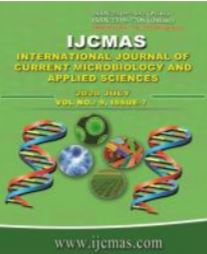


 National Academy of Agricultural Sciences (NAAS)
National Academy of Agricultural Sciences (NAAS)

|
PRINT ISSN : 2319-7692
Online ISSN : 2319-7706 Issues : 12 per year Publisher : Excellent Publishers Email : editorijcmas@gmail.com / submit@ijcmas.com Editor-in-chief: Dr.M.Prakash Index Copernicus ICV 2018: 95.39 NAAS RATING 2020: 5.38 |
Bambara groundnut (Vigna subterranea L. Verdc.) is an indigenous, drought-tolerant, underutilized African food legume, with the ability to fix atmospheric N2 in symbiosis with soil rhizobial bacteria. Our work aimed to analyze the genetic diversity of 15 bacteria isolated from root nodules of Bambara groundnut coded RVC in Côte d’Ivoire and to evaluate their symbiotic characteristic in order to select the most efficient strains as biofertilizers. Molecular analysis of these isolates using 16S rRNA gene sequences revealed distinct evolutionary lineages related to the genus Rhizobium (80%), Bradyrhizobium (13.3%) and Ensifer (6.7%). Specifically, these isolates were very closed to B. yuanmingense, Rhizobium sp. A2Ec4, Rhizobium sp. HIN2, R. alamii CK-8, R. sullae SCAU26, Rhizobium sp. UFLA 02-232, Rhizobium sp.UFPI-38 and Ensifer sp. PZS-S05. The nodulation test showed significant differences (P<0.05) in nodule number (18 and 87/plant) and dry matter (21.67 and 289.33 mg/plant). Besides, the isolates RVC25, RVC50, and RVC13 exhibited the highest infectious capacity with a means of symbiotic effectiveness ranged from 42 to 83%. The isolate RVC25 was scored as highly effective (83%). Thus the strain RVC25 characterized as R. alamii was identified as having interesting symbiotic features to improve the Bambara groundnut production. Symbiotic parameters had a significant contribution to growth, health and yield of the host plant.
 |
 |
 |
 |
 |